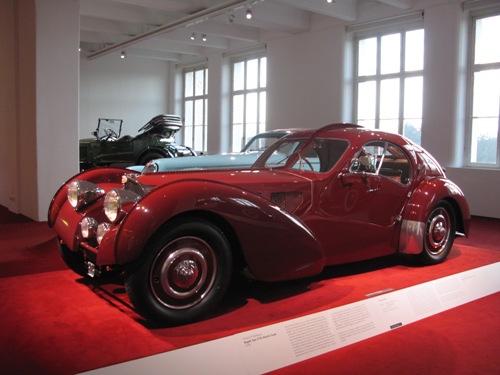
Alfa Romeo 8C 2900 B Lungo
1938
It was said to be the fastest road-going car of its time. Accelerating to 100km/h in 9.2 seconds and with a top speed in excess of 180 km/h, the 8C B Lungo’s racing antecedents were impressively clear. The eight-cylinder in-line engine with twin superchargers was derived directly from the legendary Grand Prix Tipo-B P3 single-seater of 1934. The wheel suspensions and brakes had also initially been designed for motor sport. Clearly, what makes this car so special is its body: with the "superleggera" version, Carrozzeria Touring of Milan achieved a much regarded combination of lightweight design, streamlined body, and elegance, which contributed greatly to the reputation of the 8C B Lungo as Alfa's most elegant sports car of the interwar period.
The tough reality of motor racing held out the promise made by the original design: between 1935 and 1938, Alfa 8C 2900 race cars won consecutive Mille Miglias, Italy's most prestigious endurance races. With ten victories between the wars, Alfa Romeo remained the competition’s most successful make. In 1947, in the first such "1,000 mile" race after World War II, Clemente Biondetti and Emilio Romano once again claimed victory for Alfa with an 8C 2900 B Lungo. It was to be the last. What remains is the legend. Twelve years after its first appearance, the engineering of the eight-cylinder Alfa with a displacement of 2.9 litres once again proved its worth on the demanding Mille Miglia course.

Bugatti Type 57SC Atlantic Coupé
1938
It is said that the beauty is in the eye of the beholder, but that is a fallacy. Empirical proof was furnished in 1936 by the automobile designer Jean Bugatti, the son of the eponymous company's founder, with the first model of the Atlantic coupe body for the Bugatti 57S. Its elegance was derived from riveted aluminum panels, aesthetics that we controversial at the time, but then, so was Botticelli's Birth of Venus. Yet even great creators need inspiration. The Atlantic was based on the Aérolithe concept car, which was also built by Bugatti. Its metallic skin consisted of Elektron, an aluminum and magnesium alloy; as it was a combustible material, it could not be welded. The necessary riveting of the Aérolithe became a trademark style of the Atlantic, intentionally evoking associations with contemporary aircraft construction because of its harmoniously flowing aerodynamic shape and its semi-slliptic side windows. Jean Bugatti achieved an additional sporting effect by lowering the chassis, a design feature signaled by the "S" for surbaissé, in the type designation. The "C" stood for compresseur', indicating a performance increase in the eight-cylinder engine of 60 bhp compared with the standard Type 57 engine.
Beauty must, of necessity, be rare to qualify as such. After a prototype, only three Atlantics ever left the Bugatti workshops at Molsheim in the Alsace. Two have survived to this day in the original condition.

Delahaye Typ 135M
Compétition Coupé Long
1938
"Solide comme une Delahaye" was an advertising slogan used for passenger vehicles between the wars. The slogan referred to the automobiles' longevity, but also to a certain extent to the trucks manufactured under the same factory roof. In the mid-1930s, Delahaye sought to alter its image and successfully took part in long-distance races, then merging with Delage, which was much more active in the manufacture of race cars. One of the results of this new market positioning was the Delahaye Typ 135, with the models Sport normal, Coupe des Alpes, and Compétition. With a 120 bhp engine, outstanding brakes, excellent driving comfort, and ample storage space, the Copétition model in particular boasted a number of convincing selling points as a fast touring car designed for its affluent clientele. One such selling point was the coachwork by Henri Chapron. The unostentatious beauty and harmony of its line, unspoilt by cheap frills, lives on undiminished by the decades – like this entirely unaltered "Delahaye Type 135M Compétition long" with long wheelbase.
The Delahaye company came to and end after the war, the logical outcome of the economic aesthetics imposed by market laws. A higher tax on automobiles with large engines and the lack of capital to fund further developments in the early 1950s depleted the company's assets. Delahaye was taken over by Hotchkiss in 1954, and two years later the name disappeared for ever.
